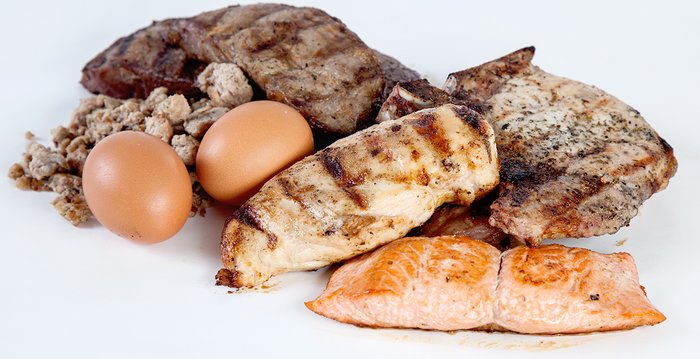The term "broscience" makes it sound like only bodybuilders are guilty of propagating pseudoscientific information. But spend time in any gym or online forum, and you're just as likely to hear questionable bro-wisdom from a powerlifter, a physique competitor, a personal trainer, CrossFit coach, your selfie-snapping bestie, or even that spindly hardgainer talking your ear off in the locker room.
Are you still laboring under one of these misconceptions? Here are three common bro tips that need to be put to bed!
Myth 1: More Protein, More Gainz
It's no secret that protein plays a major role in repairing and rebuilding muscle. That's because the building blocks of protein, amino acids, are what come together to form your hard-earned muscle. But when the discussion turns to the optimal protein intake to maximize muscle growth, things quickly gets muddy. You'll find zealots swearing by numbers as various as a gram per kilo or pound of bodyweight, two grams, or even more. Further confusing things are all those legends about bodybuilders of yore crushing man-sized piles of eggs, fish, and steak on the daily.

Protein deserves a lot of attention when trying to build muscle and strength, but not all of the attention.
Given that protein's inherent role is repairing and rebuilding muscle mass, it makes sense that eating more protein will lead to more muscle growth without limit, right? Well, not quite. Protein definitely has a major impact on muscle-building, but there's also a point where it comes crashing into the Law of Diminishing Returns.
Recent research published in the Journal of Sports Sciences states that optimal adaptations from protein can be achieved by consuming 0.8 grams per pound of body weight daily.[1] That means that cramming 300 grams of protein each day into your 185-pound frame isn't going to produce much more results than 150.
By investing all of your calories in protein, you also leave little to invest in carbohydrates, which are your muscles' primary energy source. Instead of having the fuel to train hard and recover quickly, you're left struggling with meal prep, expense, bloating, and the type of gas that will test every relationship in your life.
Myth 2: Total Daily Protein Intake Matters More Than Meals
Ask someone how much protein they eat, and you'll almost inevitably get an answer that reflects either the sort of ratio described in Myth 1, or a single number, such as "250 every damn day, brah!"
Here's why that's the wrong approach: Research published in the Journal of Nutrition found that an even distribution of protein throughout the day—30 grams at three meals—had a more positive impact on levels of muscle protein synthesis (MPS) than the same amount in a skewed distribution of 10, 20, and 60 grams respectively.[2] The takeaway is that the amount of protein you eat at each meal is probably more important than the amount you eat in a 24-hour period.
When you eat protein, the amino acids—leucine in particular—initiate a temporary muscle-building response. Failure to eat enough per meal results in lackluster stimulation of this response. To maximize this response, you need to eat a minimum amount of protein. This point is often called the "the leucine threshold."

If your goal is to build muscle, you'd be foolish not to eat 25-35 grams of protein every few hours.
In the above study, researchers hypothesized that the skewed distribution group only reached the leucine threshold once per day, while the even group reached it three times per day.
It's estimated that 2-3 grams of leucine is necessary to optimize the growth response. However, age, size, and sex heavily influence this recommendation.[3] For most people, this translates to 25-35 grams of high-quality protein per meal. To truly maximize muscle building and recovery, prioritize complete proteins, which are rich in leucine.
So, how do you reconcile this approach with the approach we just discussed in Myth 1? Simple: Calculate your ideal daily intake, and then divide it into the number of meals you need—and are comfortable eating—to meet that goal. For many, three solid meals won't cut it. That's where protein-rich snacks, shakes, and BCAA supplements can be handy.
Myth 3: You Must Load Creatine in Order for It to Work
Your workout buddy has been heckling you to buy creatine for months now. "Just 5 grams per day, that's all it takes," he says. "But you've gotta load it first." Looking at the supplement label seems to back him up, since most of them mention taking 20 grams per day, split over 2-4 doses, for the first 7-10 days. That seems like a lot to remember. What's a newb to do?
Luckily, after years of research, we can speak pretty confidently about how supplemental creatine works and how you can make it work for you. Creatine, we know, is already produced in the body in small amounts. The goal of creatine supplementation is to maximize saturation in muscles stores. The "loading" protocol is recommended to maximize saturation in as little time as possible. And yes, it works. But no, it isn't the only way that works.

Loading creatine works, but it's not the only way to reap the benefits of supplementation!
For athletes who need to peak for an event in the near future, like less than a month away, a "loading" phase does have value. The standard loading recommendation of 20 grams per day in split doses will result in peak saturation sooner rather than later. However, the loading phase is also the only time you'll see the most common side effects of creatine, including gastrointestinal distress and weight gain due to superhydration of the cell.
For the majority of the population who isn't training for an immediate competition, there's no need to load. Instead, take 3-5 grams of creatine per day, every day. Yes, the rate of creatine saturation will be slower with this approach, but within 28 days, stores will be maximized and maintained.[4]
Follow the slow-and-steady method, and you'll get all of the upside of this great performance-booster and none of the downsides. So ask yourself: What's the rush? If you don't have a good answer, you don't need to load.
References
- Phillips, S. M., & Van Loon, L. J. (2011). Dietary protein for athletes: from requirements to optimum adaptation. Journal of Sports Sciences, 29(sup1), S29-S38.
- Mamerow, M. M., Mettler, J. A., English, K. L., Casperson, S. L., Arentson-Lantz, E., Sheffield-Moore, M., ... & Paddon-Jones, D. (2014). Dietary protein distribution positively influences 24-h muscle protein synthesis in healthy adults. The Journal of Nutrition, 144(6), 876-880.
- Norton, L., & Wilson, G. J. (2009). Optimal protein intake to maximize muscle protein synthesis. AgroFood Industry Hi-Tech, 20, 54-57.
- Hultman, E., Soderlund, K., Timmons, J. A., Cederblad, G., & Greenhaff, P. L. (1996). Muscle creatine loading in men. Journal of Applied Physiology, 81(1), 232-237.

